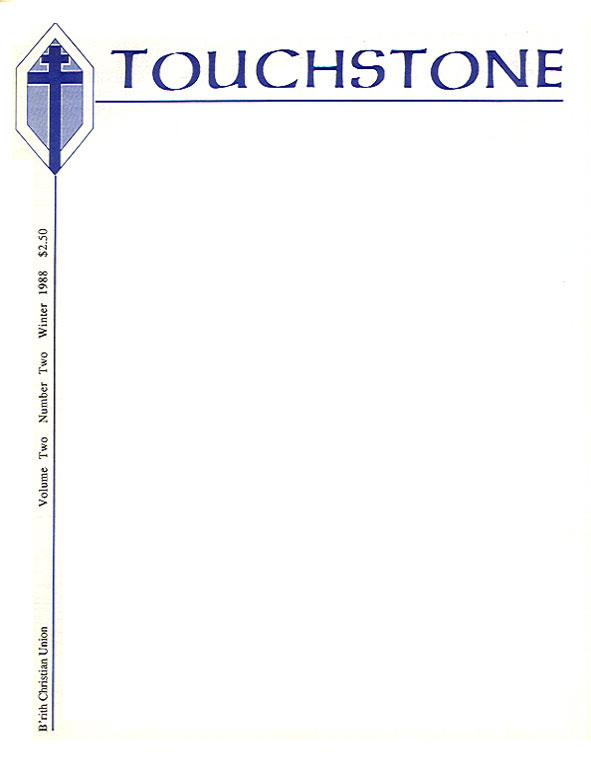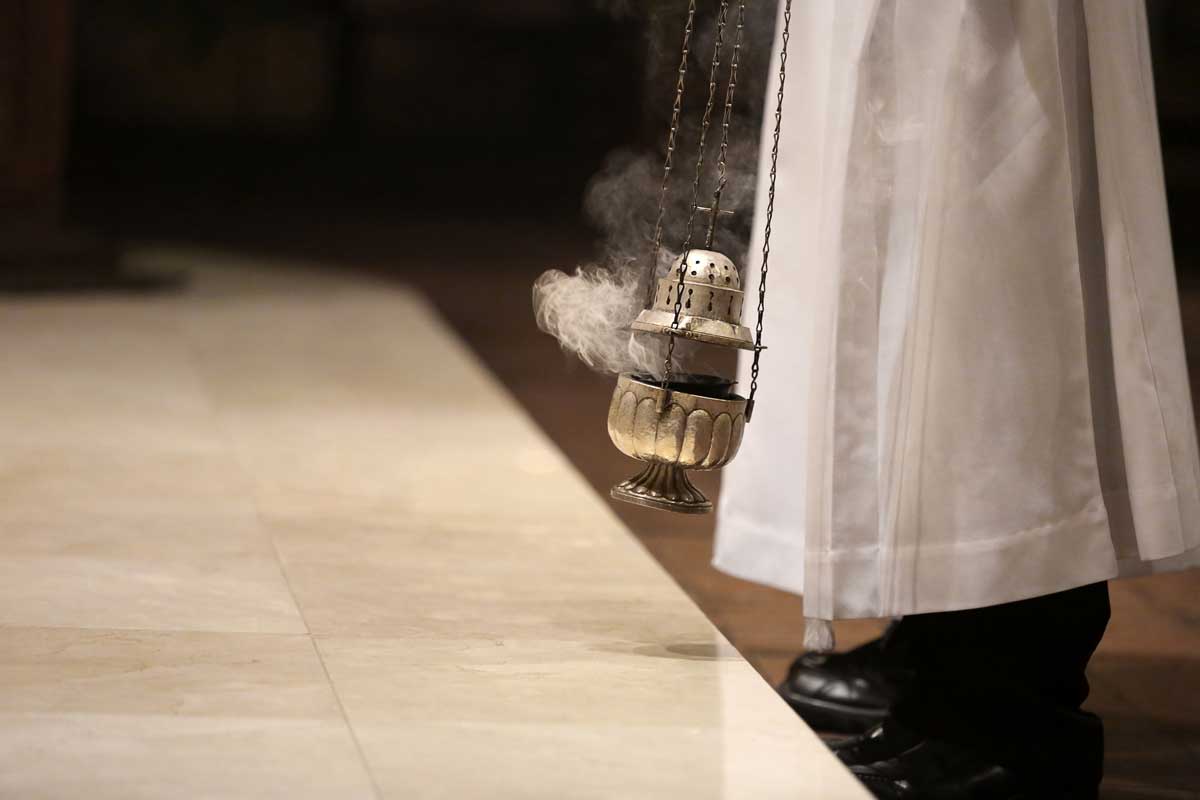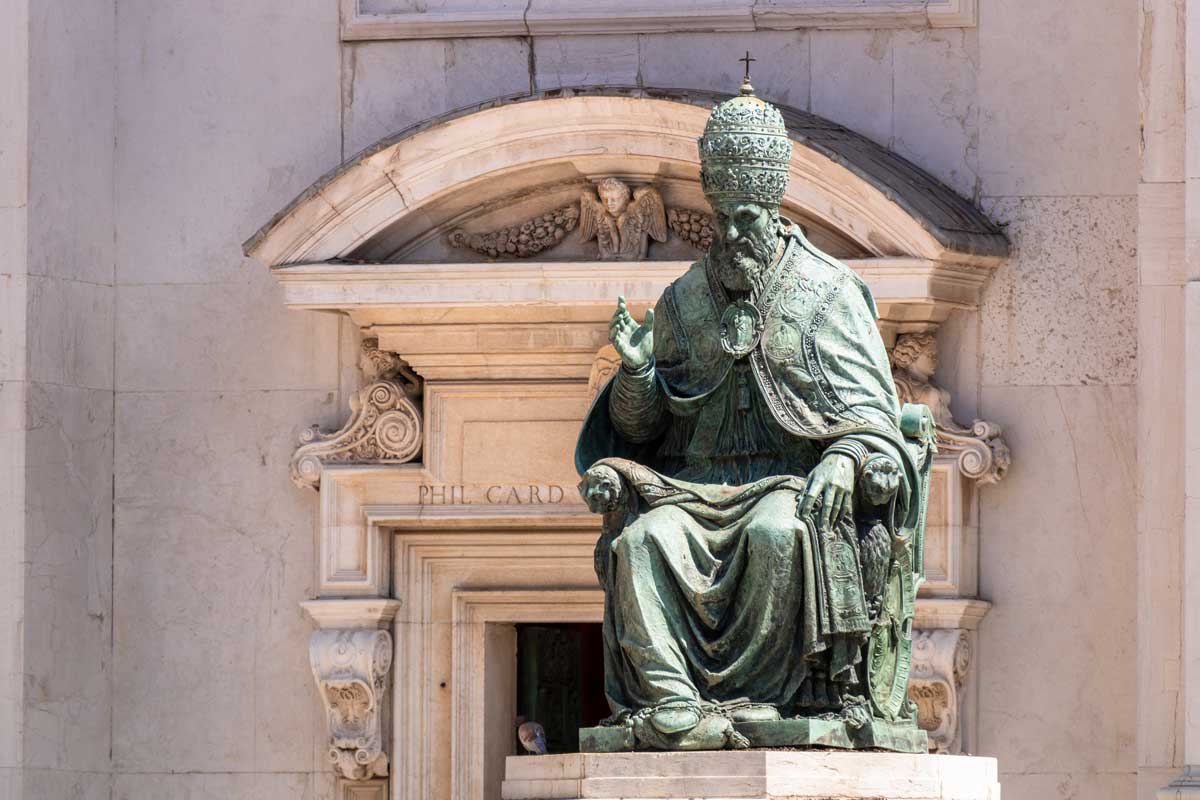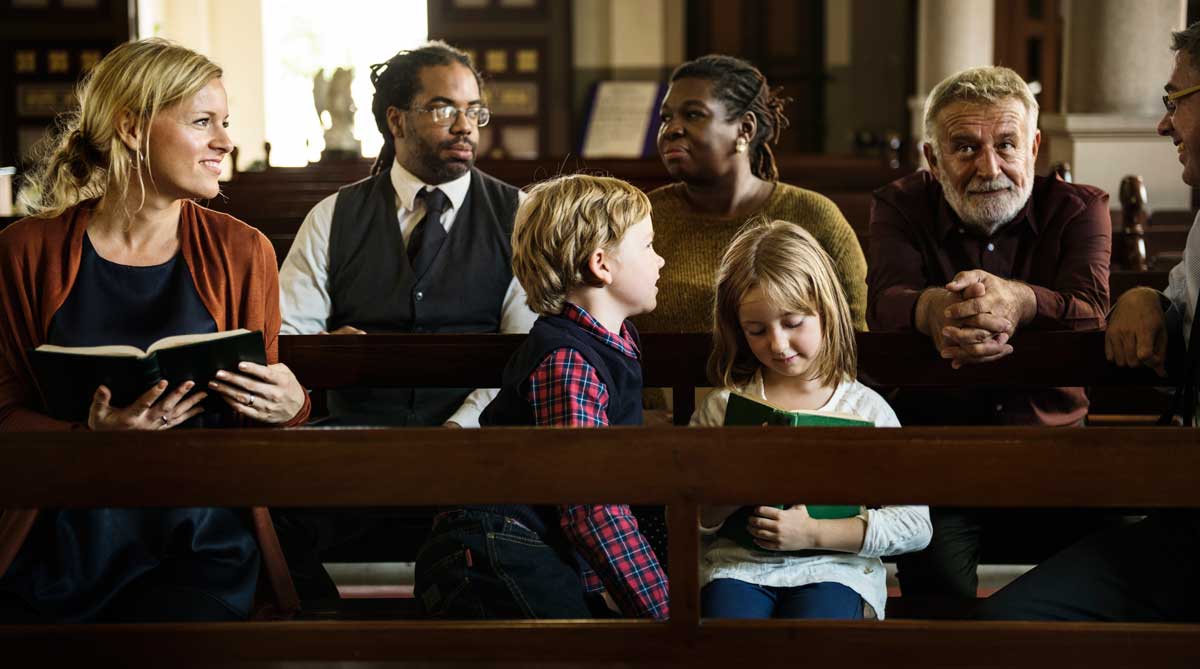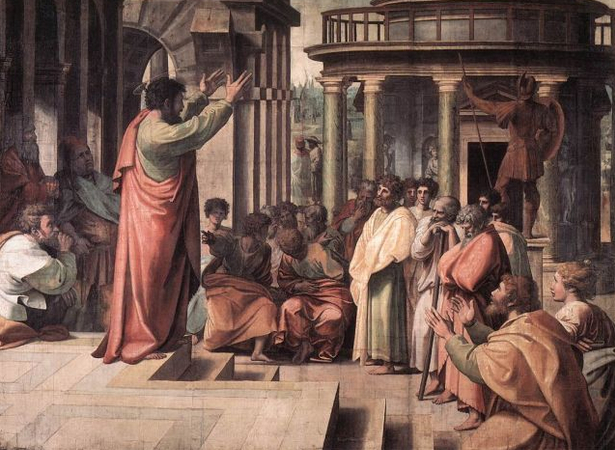The Chicago Call Ten Years Later
by Michael F. Gallo
It followed America’s so-called “Year of the Evangelical”—in May 1977 a group of forty-three Evangelical leaders and thinkers convened in an old Catholic retreat center outside Chicago to produce a call for fundamental reforms and redirection in contemporary Protestant Evangelicalism. Particularly prominent among their concerns was the need for Evangelicals to rediscover a greater continuity with historic Christianity, a fuller sense of worship and sacrament, and the importance of church unity and authority. And the tone of the Call was set by such phrases as: “we decry,” “we confess,” “we deplore,” “we suffer,” “we fail.” Like a small puff of smoke on the theological horizon, The Chicago Call betokened a type of fire, a ferment beneath the surface of an apparently prospering Evangelicalism.
The Background
It all started with the conception of Dr. Robert Webber, professor of theology at Wheaton College. Webber felt that contemporary Evangelicalism, far from being in a state of robust health, was actually weak and impoverished due largely to its insufficient rooting in the Christian tradition. Webber contacted three associates whom he thought to be of like mind: Donald Bloesch of Dubuque Theological Seminary, an Evangelical professor who taught such unlikely fare as a reconsideration of monasticism and a course on the saints; Thomas Howard, a popular professor of English at Gordon College and author of books such as Christ the Tiger; and Peter Gillquist who had left an impressive ministry with Campus Crusade to form a network of house churches, the New Covenant Apostolic Order (NCAO). These men, all of them critical of popular Evangelicalism, responded positively to Webber’s initiative. Together with a few other friends, they began to plan a conference to discuss what they considered critical Evangelical needs. An agenda emerged; invitations were sent out. (Unfortunately, prominent evangelicals outside the U.S. who were invited did not attend—people like F.F. Bruce, J.I. Packer, and John Stott). Then, on the first of May the three-day conference convened to forge a statement.
The participants had come to explore the dimensions of a perceived dilemma; they had not come to organize a new movement. Indeed, it is unlikely that they could have organized much in common at the time, since there was such a diversity of perspective among them. A number of those who represented a more traditional Evangelicalism were surprised and disturbed by the “Anglo-Catholic” element at the conference. (Webber, Howard, and Gillquist represented the “more catholic,” “high church” tendencies: Webber was already a “catholic-minded” Anglican, deeply influenced by patristic thought; Howard would eventually convert from his twenty-five year membership in the Anglican communion to Roman Catholicism; and Gillquist would lead his flock into the Eastern Orthodox Church.) Still, despite a diversity of perspective and deeply held views, a basic consensus was reached as all but one of the forty-three conferees signed the final statement. There was a common sense of addressing authentic needs for what Lane T. Dennis, President of Crossway Books and Good News Publishers, which published the Call, would call a “fuller representation of the faith.” While some saw the need for Evangelicals to return to a “catholic” concept of the Church, others, like David Wells, saw nothing of the kind. But common to all, was a repudiation of Evangelical reductionism, the gross simplifications which omit and distort elements basic to historic Christian faith and order. Eight areas of need were cited in the points of the Call. (For the text see pages 12-14.)
Shortly after the issuance of The Chicago Call, Christianity Today, the premiere periodical of American Evangelicalism, published the text. Later Newsweek brought the event to the attention of the nation at large. And still later that year, Thomas Nelson, Inc., which had sponsored the conference and for whom Peter Gillquist was a religion editor, published a follow-up book, The Orthodox Evangelicals. (They printed 5542 copies of the book, not a very long run.) After that, little more was heard of The Chicago Call. In time that small puff of smoke on the theological horizon dissipated. Yet traces of it can still be seen from time to time, as references to it continue to pop up.
The Call’s Ongoing Significance
Why does it still come up? What is its ongoing significance? The answer lies in the fact that the Call represented an unusual agenda for Evangelicals. It was truly unique in the way in which it challenged some very deeply held presuppositions. It was newsworthy simply because it represented a new kind of stirring, a new possibility in Evangelicalism. Whether widespread or limited, something had begun to stir. Witness the moves of several prominent Evangelical leaders into “high church” communions. Witness the growing demand on Evangelical campuses and seminaries for church history and the growing interest in liturgical worship. Witness the very fact that Evangelicals could come to such thoughtful self-criticism.
Assessing the Call’s Impact
Yet, how great was the actual impact of the Call? how widespread the phenomenon it represented? A good number of the original participants and several other knowledgeable observers were kind enough to offer us their evaluation of the Call now, some ten years after the event.
One thing became clear very quickly: there was not much of a direct impact on people outside of the participants themselves, outside of their own circles and ministries. The massive conglomerate that makes up Protestant Evangelicalism scarcely felt a tremor. Peter Gillquist gives perhaps the most positive assessment of the Call’s value. He believes that the Call “put Evangelical Christians on notice that it is indeed possible to be both Evangelical and historically orthodox.” In his own experience he has worked with a number of people “who were awakened to Orthodox Christianity through the Chicago Call” and joined the Evangelical Orthodox Church (EOC), which he helped to found in 1979. (In 1987, he led 2,000 of the EOC people, approximately two-thirds of the original group, into the “canonical Orthodox Church,” where they are now known as the Antiochan Evangelical Orthodox Mission.) For the EOC people the Call would naturally be a milestone in their spiritual pilgrimage. Still, this barely constitutes the proverbial drop in the bucket.
Thomas Howard, on the other hand, takes a far less optimistic view of the Call’s overall impact: “It came to virtually nothing.” Although he knows of a few people who have been encouraged by the reading of the set of essays in The Orthodox Evangelicals, “people who were already reading the Church Fathers and exercised about the mystery of the Church,” Howard says, “I have not seen any impact on those whose ecclesiology has been comfortably Evangelical.” Like most of the signatories who responded to our queries, Donald Bloesch takes a middle course, suggesting some positive results. The Call may have “aroused Evangelicals for Christian unity, for church authority, for creeds and confessions, and for the catholic heritage of the Church,” but, he is quick to add, “I don’t see any move toward a practical appropriation of this catholic heritage of the Church.”
Limiting Factors
If the Call truly offered such a unique agenda and addressed authentic needs in the Evangelical community, why was the impact of the Call not greater? Dr. Dennis points to one limiting factor: there simply was no organizational structure established to implement its concerns. As examples of more effective conferences, he cites The Chicago Declaration which gave birth to Evangelicals for Social Action, the Lausanne Covenant which set up an ongoing committee to carry out its concerns, and the ICBI (International Council on Biblical Inerrancy) which recently completed an extensive, ten-year program of publishing and conferences. Apparently, the initiators of the Chicago Call conference had no intention of forming any sort of follow-up organization or networking to reach the rank and file of Evangelicalism. In Webber’s response to the New Oxford Review’s “Symposium on the Chicago Call” (May 1979) he stated his purpose was simply to feel out the Evangelical community “to determine what kinds of concerns were shared.” No doubt there was the hope that the issuance of the Call itself would elicit some type of spontaneous, favorable reaction. Follow-up was left to individual efforts in writing, preaching, and teaching. The goals of the conference were general and open-ended.
Another factor which enters in is that the real audience to whom the Call was directed was itself very limited; the Call was not a popular address. Benedict Viviano, the sole Roman Catholic participant, saw the Chicago Call as “an elite appeal to an elite.” This was unquestionably true. Yet, even in the academic circles of Evangelical institutions, the Call only had a marginal effect. It spurred some discussion, but generated no momentum.
The General Insensitivity to the Call
Arguably, the climate in Evangelicalism was not ripe, not responsive. There was no significant, spontaneous reaction from any quarter. The Call failed to spawn, even indirectly, other efforts reflecting its agenda. Neither have there been many unrelated efforts of a similar nature. Webber notes that “Evangelicals by and large are still ahistorical and insensitive to the thought of the Church prior to the Reformation.” Howard says, “I think that Protestant Evangelicalism is not moving in the direction which the Call indicated. It’s very vigorously asserting quite a different ecclesiology and very energetically.” Whether it should have been or not, the Evangelical community has simply not been responsive to these issues.
Gillquist, ever the active agent promoting his cause, seems to take a different view and notes a growing interest in certain issues. “I get numerous letters each month from Evangelical Protestant pastors—many of them quite well-known—who are interested in learning more about Orthodoxy and even in the possibility of converting to the Orthodox Church. A professor in the graduate school at Wheaton College told me just last week that he knows of thirty-six Wheaton faculty members and their families who have joined sacramental and liturgical churches in recent years. Students at Fuller Theological Seminary in Pasadena, California, tell us that, conservatively, one-fourth to one-third of the student body favor liturgical worship and the centrality of the holy sacraments.” Such sentiments befit a mover and shaker like Gillquist, whose stated intention is to make a significant Orthodox impact on America and who is largely pitching his efforts to dissatisfied Evangelicals. Perhaps there is a potential for greater response, but to develop it will require the dedicated talents of an organizer and propagandist like Gillquist, who would continue aggressively to pitch these ideas in wider Evangelical circles.
Wariness of Hidden Agendas and Roman Catholicism
Still for all of that, there are definite obstacles to promoting these concerns, not the least of which is a wariness of a hidden and alien agenda—especially where that agenda seems to serve the interest of some party or group on the fringe of Evangelicalism. Kevin Springer, presently an editor for the Vineyard ministry and formerly a member of the NCAO (an early Gillquist ministry), says, “groups and people like the NCAO and Dale Vree (editor of the New Oxford Review) and Thomas Howard have left Evangelical Protestantism, thus forfeiting their right to speak to Evangelicals.” It is not that Springer is particularly opposed to things Catholic or Orthodox. In fact, he lauds the charismatic movement, of which he is a part, as “the bastion of Catholic evangelicalism”; but he seems, like certain others, to resent what he perceives as a co-opting of the Evangelical heritage.
Beyond a wariness of hidden agendas, there exists within Evangelicalism a deep-seated and widely-held antagonism to anything that is too Catholic: Anglo, Roman, or even Eastern Orthodox. More than one of our respondents questioned the voice being sounded by the Call. In the view of David Wells, “Anglo-Catholics” ran the conference for their own interests. Hence, for him the Call was never an authentic Evangelical voice. “The questions addressed were good,” he would say, “but the theology within which they were addressed was bad.”
Dr. Roger Nicole of Gordon-Conwell Seminary, expressed similar reservations regarding those who organized the event. “I evaluate its impact as zero”—explaining its failure as largely due to a lack of consensus on the issues of the Church and sacraments. “I for one was amazed to find at the conference a group of people who were really crypto-Greek Orthodox or crypto-Catholic, whose views I would not even remotely have thought to consider evangelical.” Although in the end Dr. Nicole did sign the statement, he explained that “the concept of sacraments was diluted so much that what was said could be acceptable by Evangelicals.”
Even Donald Bloesch was careful to distance himself from what he has seen in some churches as “a creeping sacramentalism and a creeping sacerdotalism,” though he did not consider that anyone at the conference represented such tendencies.
Changing Times
Naturally, changes in the past ten years have affected the perceived needs within Evangelicalism. How has the Call stood the test of a decade? Some say it is outdated; others say it is more relevant today than ever. Dr. Marvin Anderson, a signatory and professor of Church History at the Baptist Bethel Seminary, felt that the Call was “lost under the weightier concerns of the Lima Declaration and Inter-Confessional Dialogue in Europe and North America.” Howard Loewen, associate professor of theology and divisional chairperson at Mennonite Brethren Biblical Seminary in Fresno, California, sees the Call as “an articulate theological statement that prophetically addressed a number of the key problems faced by a North American Evangelical tradition in transition.” For him, the growth of the forces of pluralism since 1977 present Evangelicals with the need “to transpose the constructive proposals of The Chicago Call from a paradigm that stressed continuity to one that stresses the need for change and to provide a rationale for diversity within unity.”
For Donald Bloesch, however, today’s emerging needs only confirm the Call’s stress on continuity. In his view this is strikingly represented by the erosion of nothing less than the doctrine of the Trinity. The underlying problem, it would seem, is just what the Call diagnosed, historical discontinuity. “I think that the problem has accelerated,” says Bloesch. “The ‘new spirituality’ and the New Age movement have penetrated into Evangelicalism. Heterodoxy is much more evident now in Evangelical circles than it was then.” He goes on to note a number of pressing social concerns requiring some type of Evangelical response. “The abortion holocaust, for example, not mentioned in The Chicago Call statement, is a burning social evil that should be addressed by any confessing church. It’s completely out of control and it’s an issue tearing apart the moral fabric of our country. The idea of a possible nuclear holocaust is another social evil that needs to be addressed.” A number of respondents expressed a need to call together a new forum to address these and other critical issues which have emerged in the past decade.
A Concern for Unity and Cohesion
Of the points addressed in the Call, none has continued to impress our respondents with a greater relevance than the issue of unity. Dr. Welde, head of Presbyterians United for Biblical Concerns, expressed concern for “the fragmentation within evangelicalism.” “I think Evangelicalism is suffering from the same kind of pluralism we’re suffering from in the society at large,” he states. “Evangelicalism lacks a unitive thrust.” Others, including David Wells, also noted the problem of an escalating fragmentation within Evangelicalism. “The problem is that the Evangelical center is collapsing because its substance has been eroded.” Dr. Lovelace, professor of Church History at Gordon-Conwell agrees. “Evangelicals are presently in disarray because of the emergence of a number of internal problems.” In his view, recent years have seen “a polarization between a hard-line right-wing rallying around concern for biblical inerrancy, and a left-wing accommodating more to Liberal currents. Meanwhile, the rise of the Religious Right has made many observers nervous, and the emergence of moral scandals among its major leaders has shaken confidence in all sectors of Evangelicalism.” Lovelace goes on to say, “In view of these emerging problems The Chicago Call appears as one of the strongest statements calling for maturity and internal reformation within the New Evangelicalism. It seems even more relevant now than it was when it was issued.”
Ironically, while there seems to be a significant consensus on the need for Evangelical unity and cohesion and growing alarm over its apparently eroding center, the practical questions concerning that unity bring up the type of problems which polarized and limited the impact of the Call: what type of unity should it be? how would it be brought about? and what would the substance or definition of its theological center be? In the opinion of more than one perceptive observer, it is highly questionable whether exercises in Protestant scholasticism can shore up what contemporary culture has eroded. What then? Looking at the dilemma from a position outside Protestant Evangelicalism, Benedict Viviano offered this provocative comment, “[The Evangelicals] may need a tradition of church authority which tries to combine biblical fidelity with a right division of gospel and law, which takes seriously the Petrine ministry of unity and world-wide oversight, and which though synodical results in more than limp conclusions which merely endorse contemporary fads.” He then adds, “This would indeed be a challenge.” Indeed it would be, even apart from Protestantism’s long-standing difficulties with the place of a Petrine ministry.
Conclusions
Perhaps Evangelicalism is approaching a crisis point in its not-so-long history. Though its roots go back to the Reformation, contemporary Evangelicalism essentially begins with those who, in the years after World War II, distanced themselves from Fundamentalism’s narrowness and reaction. And now some of the heirs of this broad movement are struggling with a new but similar necessity.
The Chicago Call, as we have indicated, was part of this ferment. It was neither the province of crypto-Catholics nor the limited agenda of a few fringe antiquarians who happened to like patristics and liturgy. Such characterizations are unfair. The Call’s purpose was serious and thoughtful in addressing Evangelical reductionisms and seeking to affirm a “fuller representation of the faith.” Perhaps its actual achievement was simply to express or represent these concerns, these needs, and a certain ferment among some Evangelical intellectuals. Limited though the phenomenon may have been, it should by no means be disregarded. It is worth watching, for things from the center to the borders of Evangelicalism must inevitably continue to change and develop.
So far, the specific points of the Call, which we may characterize as being catholic and evangelical, have not been communicated in a compelling way to many Evangelicals. But perhaps the point is beginning to be made—that, yes, catholic and evangelical qualities and perspectives can exist together and are meant to complement each other. The Charismatics have accomplished incomparably more than the Call in breaking down barriers between the various traditions and showing these possibilities. But there is still a need for an articulate, theological addressing of certain issues. And here the Call has had a contribution to make, and both its progress and its limitations are instructive. It offers a unique test case, not only for people concerned about things evangelical and catholic, but for those interested in the dynamics of change and reform in any sector of the Church.
Since the Call
In the nearly eleven years since the Call what has happened with the four leading initiators?
Robert Webber
After the conference Webber published Common Roots, which some saw as more in keeping with the direction of the Call than the Call itself. It sold 2000 copies and is now reprinted as The Divine Tapestry. Ten years later his own thinking has not changed. “I have only added to the depth of my understanding,” he says. “More than anything else, worship has captured the imagination of evangelicals.” But, he adds, “the historic understanding of worship is still sorely lacking.” In addition to having written two books on the subject, Webber also conducts seminars in local churches on the nature and practical appropriation of historic worship.
Donald Bloesch
In 1982 Donald Bloesch published a two-volume work, Essentials of Evangelical Theology, in which he “tried to build bridges between Catholic and Evangelical faith” (New Oxford Review), In 1983 Doubleday published his The Future of Evangelical Christianity: A Call for Unity Amid Diversity, which in part addresses some of the concerns of the Chicago Call conference. Concerned about the erosion of the traditional Christian deposit by various heterodox forces today, his latest work is Battle for the Trinity. His perspective after ten years is that “the forces of secularism or secularization have penetrated evangelicalism today.”
Thomas Howard
Since the call Thomas Howard wrote two books on its theme, Evangelical is Not Enough—a critique of evangelical reductionism, and Splendor in the Ordinary—expressing a sacramental view of life (both now out of print). He was received into the Roman Church in 1985. Says Howard, “I believe that a full and sober consideration and understanding of what the mystery of the church is would in fact lead a man to make his obedience to the ancient church—Roman or Orthodox.” Howard would now understand the eight points of the Call from a traditionalist Roman Catholic viewpoint.
Peter Gillquist
In 1979 Gillquist published The Physical Side of Being Spiritual. He and several NCAO fellow-signers formed the Evangelical Orthodox Church that year. The end of the road for Gillquist (and Jon Braun) was in the East with the Antiochian Orthodox Archdiocese. (One-third of the EOC under the leadership of Kenneth Jensen did not enter the “canonical Orthodox Church” but remain the EOC.) Gillquist is active in church planting and evangelism. He says, “Ten years later [my thinking] is hopefully more precise in terms of Orthodox theology. For example, I am stronger on the role of the sacraments and Church unity now.”
Michael F. Gallo , a graduate of Wheaton College, is a public school teacher in Chicago, Illinois.
subscription options
Order
Print/Online Subscription

Get six issues (one year) of Touchstone PLUS full online access including pdf downloads for only $39.95. That's only $3.34 per month!
Order
Online Only
Subscription

Get a one-year full-access subscription to the Touchstone online archives for only $19.95. That's only $1.66 per month!
bulk subscriptions
Order Touchstone subscriptions in bulk and save $10 per sub! Each subscription includes 6 issues of Touchstone plus full online access to touchstonemag.com—including archives, videos, and pdf downloads of recent issues for only $29.95 each! Great for churches or study groups.
Transactions will be processed on a secure server.
more on catholic from the online archives
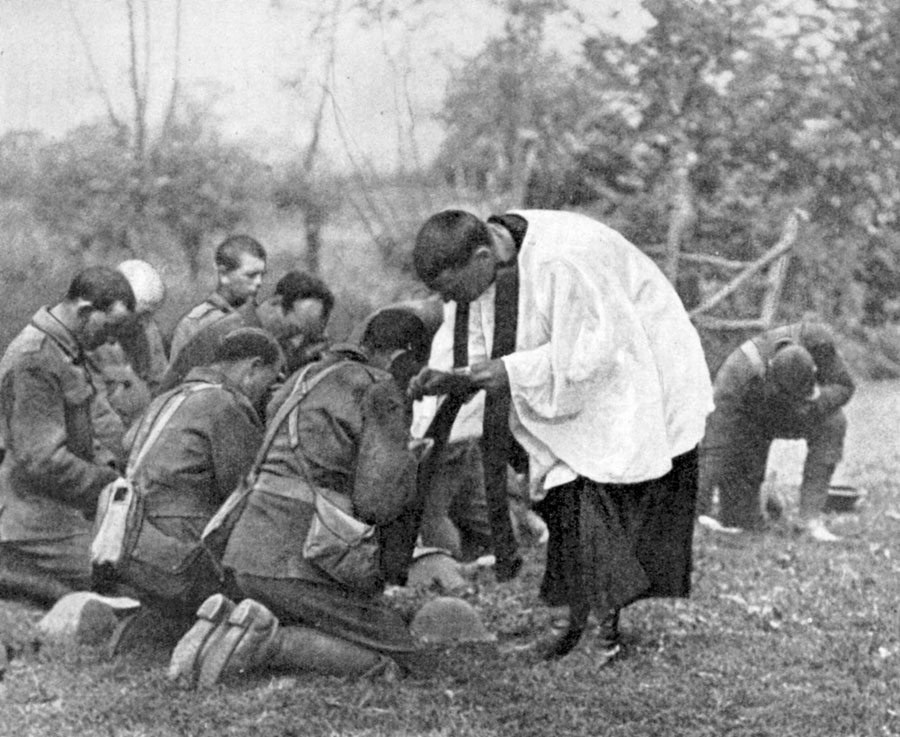
35.4—Jul/Aug 2022
The Death Rattle of a Tradition
Contemporary Catholic Thinking on the Question of War by Andrew Latham
more from the online archives
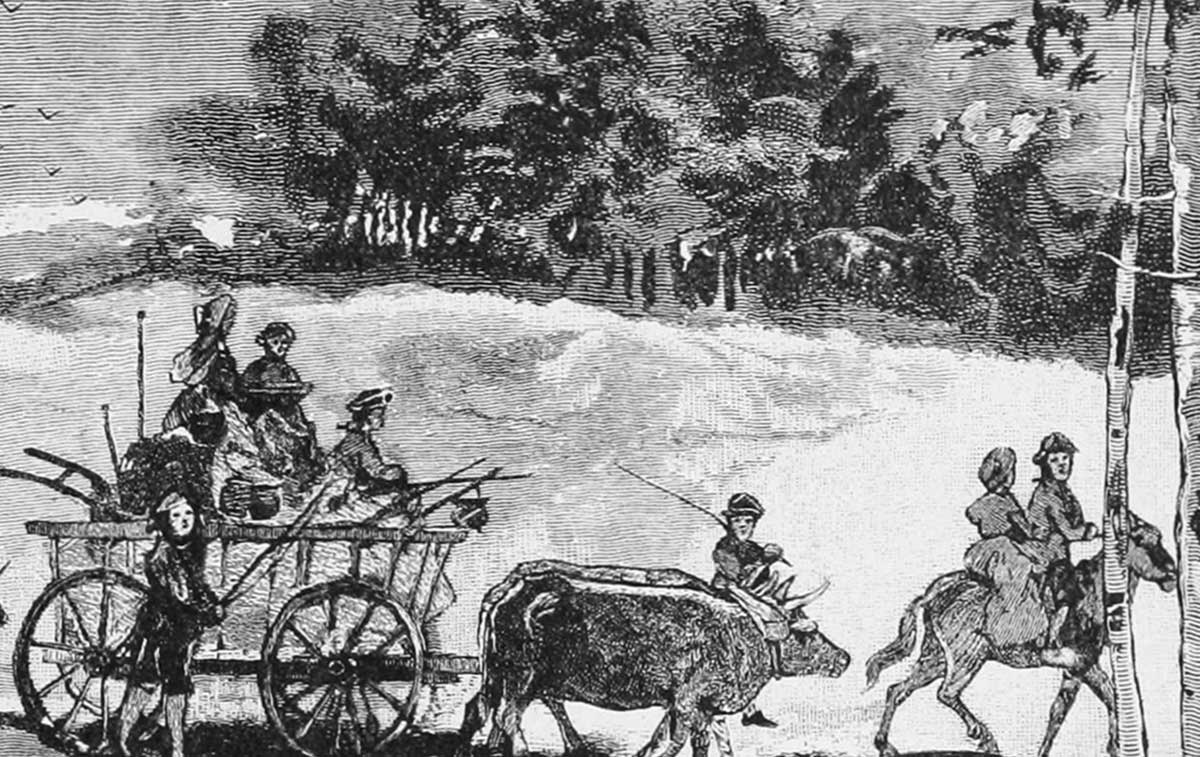
31.5—September/October 2018
Errands into the Moral Wilderness
Forms of Christian Family Witness & Renewal by Allan C. Carlson
calling all readers
Please Donate
"There are magazines worth reading but few worth saving . . . Touchstone is just such a magazine."
—Alice von Hildebrand
"Here we do not concede one square millimeter of territory to falsehood, folly, contemporary sentimentality, or fashion. We speak the truth, and let God be our judge. . . . Touchstone is the one committedly Christian conservative journal."
—Anthony Esolen, Touchstone senior editor





